The 10 Step Process for Auxiliary and Summer Program Development
At the recent NAIS National Conference, SPARC Senior Advisors Karen McCann McClelland and Bob Rojee led a three-hour pre-conference session to help auxiliary professionals develop their programs or launch new initiatives. Whether you're looking to increase enrollment, generate revenue, enhance participant experience, or all of the above, the SPARC 10 Step Process for Program Development is a valuable reference to keep you grounded and focused as you begin a new program or expand an existing one.
As an ice-breaker activity, Bob and Karen asked workshop attendees to draw a picture of their 'ideal auxiliary leader.' This exercise helped them to think through the variety of skills they need on the job and led to at least one connection among the participants.

Participants then talked through what their drawings portrayed. Note the flexibility of the cheerleader; the many arms needed to juggle multiple responsibilities; the good communication skills of the dialog bubbles; the many hats worn to fill many roles; and the dollar bill to show creating ideas to generate revenue.
With the goal of creating an 'action plan' suited for the multifaceted skill set of auxiliary leaders, McClelland and Rojee outlined and discussed at length the plan’s 10 crucial steps. Below is a summary of their presentation, including essential SPARC tools (downloadable and free for SPARC members) that provide valuable help in developing and evaluating new or existing programs.
Step One: The Business Plan
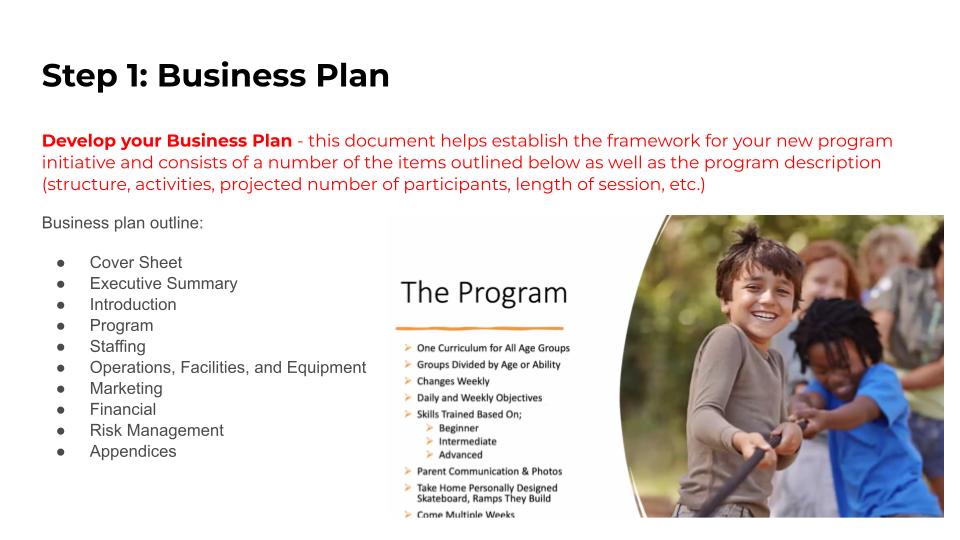
The program description is a key component of the business plan. When writing the description, ask: What is the basic premise of your program? What differentiates it from other programs? What is the hook?
Prepare an elevator pitch to introduce your program. Write an elevator pitch by answering: What is your program? What makes it stand out? What are your goals? What problem does it solve? How does it solve it?
End with a personalized message and a Call to Action, or CTA. Here’s an example:
Our new summer program is the perfect way to stay active and have fun this summer! With a variety of activities such as swimming, hiking, and biking, there is something for everyone to enjoy. Our experienced and certified staff will be there to help you every step of the way, ensuring that you have a safe and enjoyable experience.
Step Two: Define Your Vision and Goals
When defining the vision and goals of your initiative, ask:
- What is your statement of purpose—what are you trying to achieve?
- Reflecting on your overall program mission and goals, how does this new initiative build on your existing foundation and value proposition?
- What is the program philosophy and how do you envision the culture of your program?
Consider how the vision and goals of your program align with the mission of your school and the opportunities and needs of the market and community. While they each have distinct needs, there should be an overlap between all three, so everyone is working toward the same purpose.

The SPARC Auxiliary Program Strategic Priorities Forced Ranking Tool can help you think through how you want to delineate your new program’s goals, what aspects to highlight while developing the description and pitch, and in which ways your program’s priorities will align with those of the school and your community.
Step Three: Identify Your Audience

Identify both the participant and family profile (who is your target market and why?) and the staff profile (how will you recruit, onboard, and train the staff?).
Here are examples of profiles from The Velocity Adventure Camp held at Haverford College and Sidwell Summer:
Camper Profile:
- Kids ages 5-10
- Not every kid is athletic, but they need to move their body
- Enjoy the outdoors and be active
- Love to play
Counselor Profile:
- Great attitude
- High energy
- Kind, nurturing, and compassionate
- Loves working with kids
- Has knowledge of the skills we teach
- Has all security clearances
- Has been thoroughly trained in the curriculum and in childhood development
Step Four: Determine Market Analysis and Marketing Plan
When reviewing your competitors and other market players, identify what holes exist in their programming and how your new initiative can fill them. How can you differentiate your program in the market? What will be its strengths and assets?

Take advantage of the SPARC Compass Tool, a downloadable worksheet, to help define your marketing plan action steps.
Step Five: Create Your Budget
An operating budget acts as a tool for decision making while helping to plan out expenses, reach business goals, and anticipate any operation changes as needed to support the business. It also allows the business to understand its operation costs and can be used to track performance.
When building your budget, ideally you’ll want to project revenue, expenses, and profit, identify initial investments and purchases, and create one-to-three-year projections that reflect realistic growth. Bob and Karen shared a simple budget workshop that can help determine if a new initiative can be financially viable.
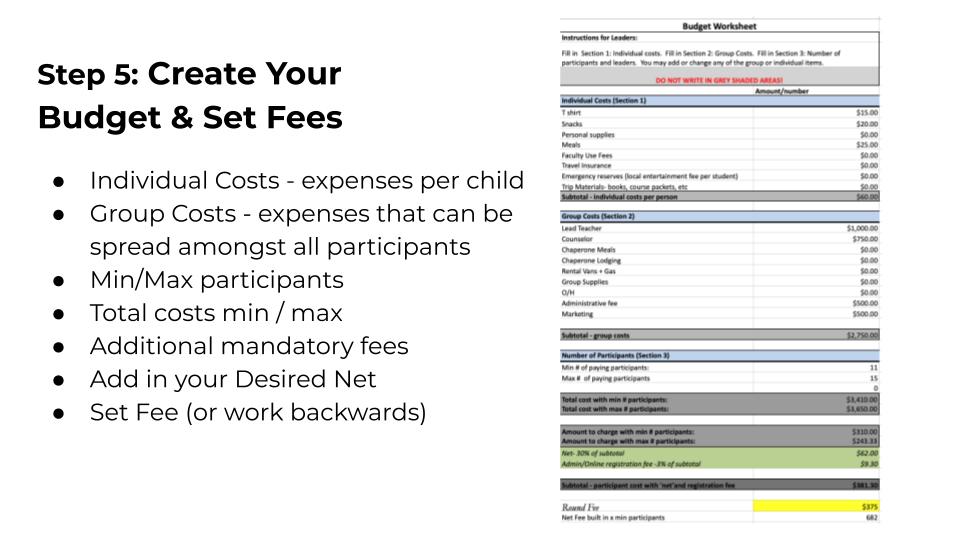
Step Six: Identify Your Implementation Needs
What does your new program need to get off the ground? Your checklist of needs should include:
- Special training or licensing - check local and state regulations
- Assigning and preparing facilities - do you have appropriate space
- Identifying a location for the program
- Resources - do you have the resources to execute programming?
- Purchasing supplies
- Developing a program curriculum
- Creating program materials (e.g. worksheets, activities, etc.)
- Recruiting and hiring program staff
- Training program staff
- Safety - are their potential hazards to be addressed?
- Promoting the program to potential participants
Plan for what location you’ll need, what staff will need to be hired, what the schedules will look like, and what policies, procedures, rules, and communication methods you will want to employ.
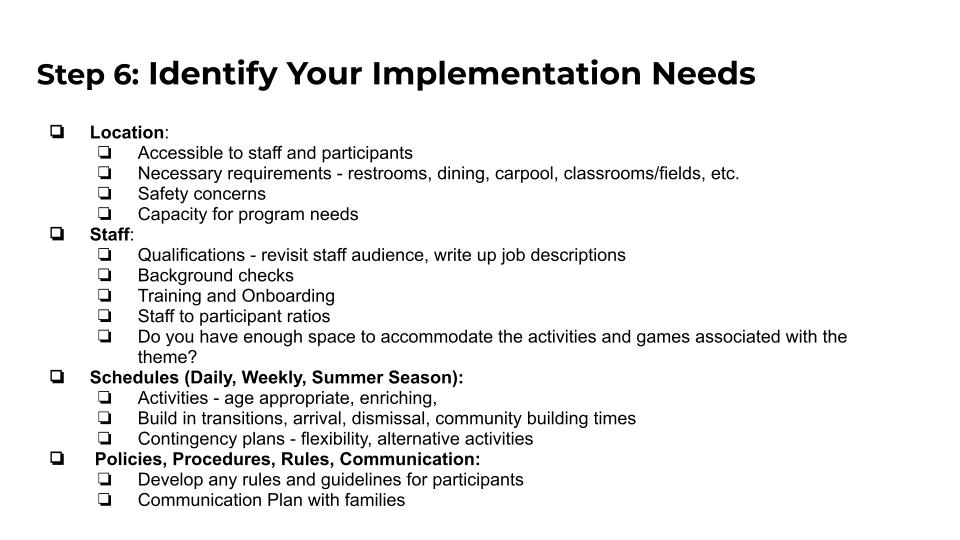
Step Seven: Develop Your Risk Management Plan
Risk Management is one of the most crucial elements of any auxiliary program. There are a number of areas to consider:
- Identify licensing requirements and specific program training, regulations, etc.
- Review program ideas for any challenges and obstacles and do an analysis with a DEIJ lens, including cultural appropriation
- Determine any effects on current emergency plans and procedures
- Train staff and participants on safety procedures
- Consider health screening—medical conditions and special needs
As part of the discussion on risk management, they shared the story of a Challenge Course facilitator that was charged for not following all proper safety protocols.

Step Eight: Develop Tools and Metrics to Assess Program
Tools and metrics help determine if your program is successful. Generally, money acts as a reliable marker for measuring success, so some key questions to ask are:
- What was the gross revenue? Overall? By program?
- What was the percent of margin? Overall? By program?
- The net? Overall? By program?
- What were the fees?
- How do the above numbers compare year over year?
- Can you make some projections for the future?
- How do your expenses break down (what percentage goes to payroll, supplies, etc.)
- What were your competitor’s fees? Other financials (can you find out on Guidestar)?
- How much financial aid/scholarships were awarded?
- What percentage of the school’s overall gross revenue is from your program?
You can also use surveys and other qualitative forms of data to measure the impact of your program that are important, but more difficult to measure. Examples include: what impact the program had on participants, the school, and families; what new resources were provided to the school; how your program created goodwill with the community at large; if any strategic partnerships were developed; and if your program aided with teacher retention by providing summer employment.
Bob and Karen introduced SPARC Tools that can be used to help assess new and existing programs.
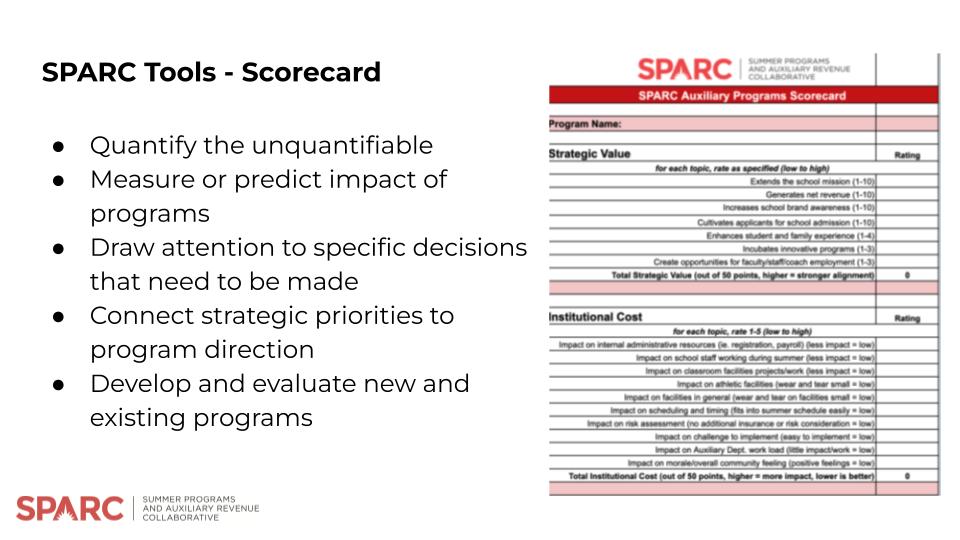
SPARC's Scorecard tool helps “quantify the unquantifiable” by measuring or predicting your program’s impact. It can bring to light any decisions that must be made while connecting strategic priorities to program direction.
The Boston Matrix tool analyzes the “portfolio” of programs and determines where to allocate resources. It ranks your program’s strategic value and institution cost, and like the Scorecard tool, can be used to evaluate new and existing programs.
Step Nine: Develop Design and Implementation Timeline
Using the SPARC Compass Monthly Task Management tool, you can determine program-specific tasks for each time frame: pre-season, in-season, post-season, first year goals, and year 1-3 growth.
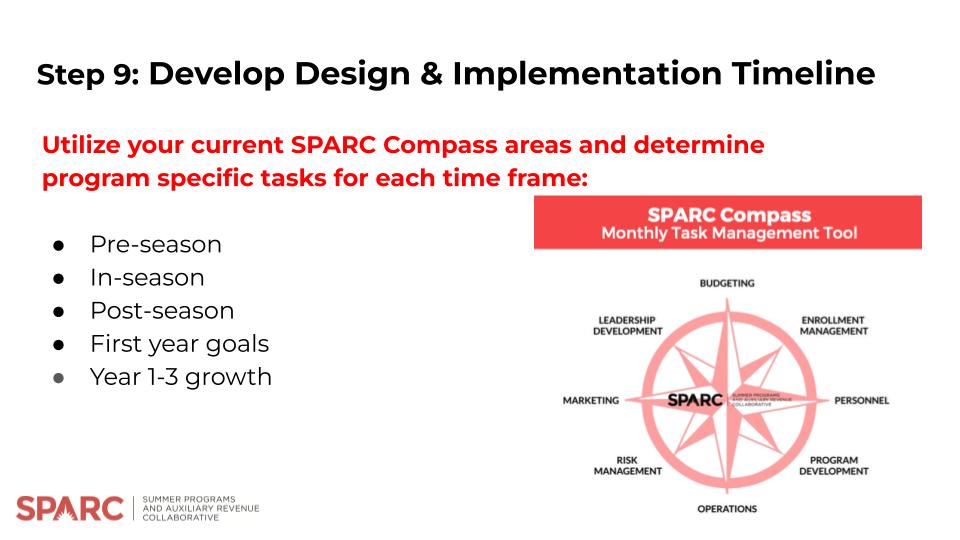
Here’s an example for the pre-season time frame:
- October
- Draft Description
- Develop Budget
- Create list of necessary supplies/facilities
- November
- Finalize web description including dates, fees,
- Talk to potential coordinator
- December
- Develop registration sessions
- Add to website
- Include in marketing materials
- January
- Launch Program - hold coffee discussion with prospective parents
- Monitor enrollment
- Review supplies and classrooms needs
- Determine hiring needs, post positions
Step Ten: Create Implementation and Analysis Process
The four phases—prepare, assess, plan, and improve—include performance assessment, data-driven improvement planning, supports for improvement implementation, and reassessment to measure results.
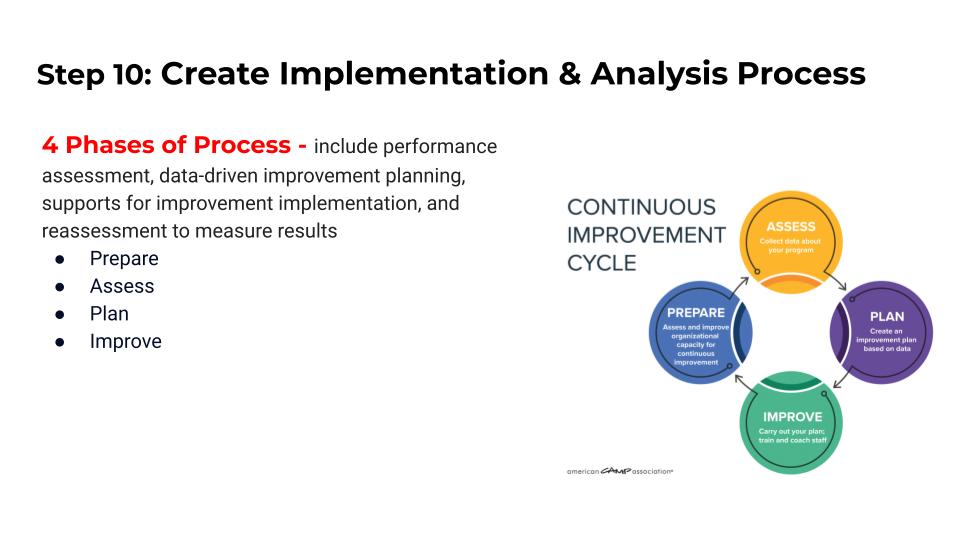
When the program ends and you begin analyzing and measuring its performance, that’s the time to talk with leadership about any new ideas or questions that have come up. These might include:
- What are the opportunity costs? For example, are rentals getting in the way of expanding more programming and revenue?
- Increase fees for next year?
- Changing the schedule (i.e. number of weeks)?
- Change in the way campus is used?
- Is there a new systems change you want to make such as scheduling, billing, etc.?
When you’re ready to plan for the next year, your 10 Step Plan will be waiting to help you launch or develop a thriving and successful program.

